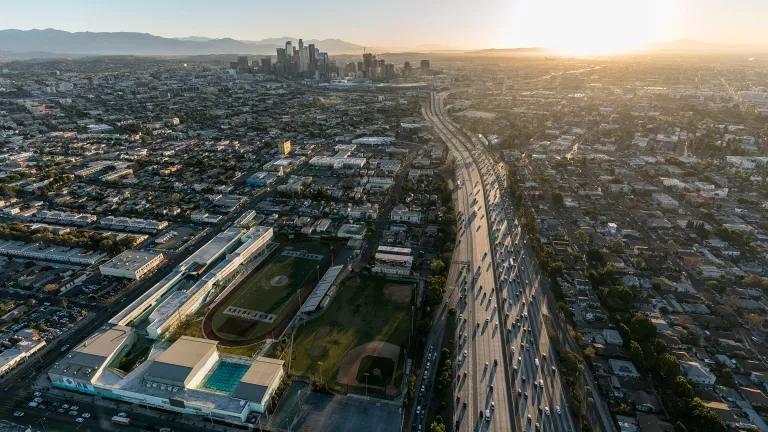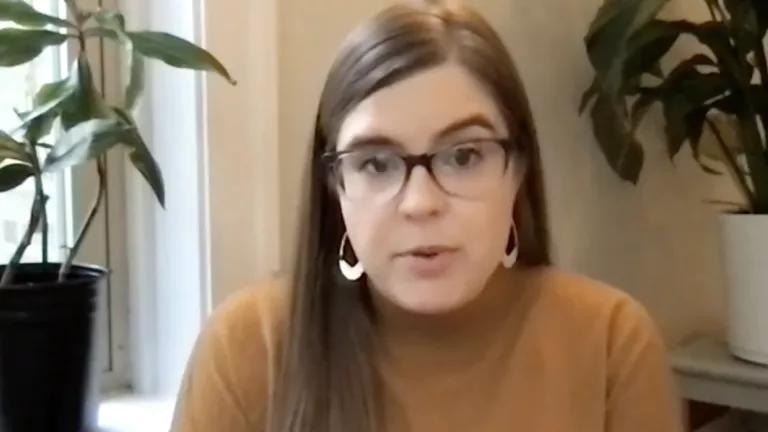Principles for Parks and Equitable Development
Assets in our communities that offer us increased connectivity, shelter, and planned outdoor spaces can act as triggers that escalate land values which usually price out existing residents, often low-income and people of color, and more often renters. But communities continue to push back and develop models for creating green space that does not come at the cost of community stability, and instead contributes to the health, well-being, and inclusivity of residents.

Design of a future park showing children playing in a grassy area above the Anacostia River at the entrance of the future 11th Street Bridge Park in Washington, D.C.
There is a frustrating truth in the world of community development: new large-scale development, no matter how much it is designed to support the existing neighborhood, often displaces or alienates some longtime residents. Whether it’s a transit project, housing project or large-scale park project, the outcomes are typically the same. Assets in our communities that offer us increased connectivity, shelter, and planned outdoor spaces can act as triggers that escalate land values which usually price out existing residents, often low-income and people of color, and more often renters.
A recent CityLab article showed that 30 percent of existing renters stay after a neighborhood gentrifies—but what happens to the other 70 percent of renters?
The 70 percent wasn’t planned for. Our planning processes and practices are founded on structural and institutional inequities, so our outcomes are in turn unequal and leave people behind.
It should come as no surprise that these same foundational inequities impact the way we develop parks and urban green spaces. Given the lack of centering equity and spatial justice in these practices, communities’ experiences of developing much needed green space are the same. This was the case for the 606 trail in Chicago, for example, which saw a 48. 2 percent increase in housing prices along the west side of the trail. Increased trail access and the increase in property value offers community benefits, yes, but it’s not shared equally. Most financial benefits are actually reaped by more educated or higher income homeowners, who may see an increase in both home values and income according to this Federal Reserve Bank of Philadelphia paper.
But truly, all is not lost. Communities continue to push back and develop models for creating green space that does not come at the cost of community stability, and instead contributes to the health, well-being, and inclusivity of residents. One such example is the 11th Street Bridge Park in Washington, D.C. The crux of the project is focusing its work on workforce development, housing, small business and wealth building, and social equity. Since the vision began, 71 full time jobs have been created in historically lower income Wards 7 and 8, more than 2,500 residents have become engaged in tenants’ rights initiatives, cultural works such as the Black Love Experience featuring music and art have been supported, and more than 7,500 pounds of fresh produce have been harvested through community-driven strategies. And one lesson that the 11th Street Bridge Park has for others is to start the work of equitable development early, countering the practice to build the infrastructure and then deal with the consequences.
“We need to flip the sequence of events—create community driven equity strategies, implement those strategies and only then create the asset (park, infrastructure, etc.). In the Bridge Park's case, by the time the park is expected to open in 2023, we'll have implemented our equitable development strategies for 7 years.”
—Scott Kratz, Director, 11th Street Bridge Park, Washington, DC
This model illustrates that green spaces can be a positive anchor for community and equitable community development, while ensuring that their wide range of social, economic, environmental, health, and cultural benefits can be captured by all members of a community. Benefits that range from free spaces for arts, to healthier air, and to improved psychological wellbeing. By centering green space development on racial equity and spatial justice, it also ensures that these spaces don’t drive up the cost of living so much that residents are displaced from their homes and unable to benefit from the improvements.
The Strong Prosperous and Resilient Communities Challenge (SPARCC) collaboratives in Atlanta, Chicago, Memphis and Los Angeles are focusing on ways to influence the equitable development of parks and open spaces and ensure that planners, environmental groups, city officials, and developers are considering housing, community preservation, economic opportunities, culture, ownership, and racial equity as part of a holistic strategy.
The SPARCC collaboratives have seen successes, such as the development of the first anti-displacement policy in the Los Angeles County Regional Park and Open Space District. Additionally, based on their own advocacy around parks and urban open spaces, the collaborative table partners have shared their own best practices and knowledge for advancing park and urban open space equity.

Principles of Park and Open Space Equity
1. Start with Community Values and Needs
Start your process early and center your project around the community’s vision and values, organizing around what is most important. Harness existing community assets and respect the lived experiences of current residents. Ask key questions such as “What is most valuable to the community? What benefits and burdens are created (economic, environmental, health) because of the new space? How does the project advance racial justice, self-determination, and inclusion? How will affordability of the neighborhood be maintained? How will local culture be respected and honored?”
Spotlight: While not a SPARCC site, the principles developed by the Seattle Office of Sustainability and Environment, offer a good example of starting with shared values: Principles of Public Space for Communities of Color. Additionally, our friends at the 11th Street Bridge Park developed a 7 step process for working with residents to create an equity plan.
2. Maintain Project Control in the Community
Projects can lose their original intent depending on the person or group managing the work. Focus on maintaining community control over the ideas and strategies to maximize the benefits the community can receive, in addition to the environmental and health value being offered. Set shared definitions of zoning overlays, affordable housing goals, and project geographies and put safeguards in place to keep people accountable to those definitions and goals. Deep collaboration is needed early and often with the group leading the work. When deep collaboration exists, groups become less reactive to displacement and lack of housing affordability because equity would ideally be embedded through the process.
Spotlight: In Chicago, the 606 trail offers many benefits to the existing neighborhood. However, during its development the 606 trail started out as a community-driven project and it quickly left the hands of the community. Advocates stated that there was an inability and a lack of structure for collaborating with the government and conservation groups, which meant less ability to elevate deep concerns and mitigate social, cultural, and physical displacement. Members of the Elevated Chicago collaborative are now pursuing strategies that increase affordable homeownership opportunities for low to moderate income legacy families and addressing the cultural and economic shifts in the neighborhood.
3. Work with Local Elected Officials
Local elected officials can either be powerful advocates or unintentional roadblocks. Advocates should ensure that elected officials understand the issues in parks and open space projects in order to properly voice support and concerns. Develop a plan to cultivate relationships with elected officials who can champion the issues and elevate the benefits of equitable parks development. Incorporate time for developing educational materials for the community and elected officials and engage in participatory budgeting processes.
Spotlight: The LA River Restoration project was originally championed in the 1980s by environmental and conservation groups. At the time, the groups weren’t thinking of nor were they able to manage housing issues. Despite being foreseeable, the scale and scope of the crisis grew, ultimately resulting in gentrification and displacement leading to homelessness for some in the community. The subsequent work of local advocates, the Los Angeles Regional Open Space and Affordable Housing (LA ROSAH) collaborative, with elected officials, city and county partners turned into the first anti-displacement policy in the parks department.
4. Integrate Arts and Culture Strategies
Arts and culture activities bring people together around the ideals that a community values most. Developing an arts and culture strategy provides an opportunity for relationship-building and affirms existing people and cultures by preserving and promoting cultural elements that can be integrated into parks and open space projects. Arts and culture also deepen community engagement and provide a platform for working creatively to address community concerns like greater local economic ownership, healthy food access, and displacement.
Spotlight: In the Heights neighborhood in North Memphis, the Heights CDC is activating three parcels of land that will house a portion of a future trail line called the HeightsLine. One portion of the space offers a place for the community to gather around arts and culture activities and engage in the design of what the space and trail line can become. The strategies also encourage residents to envision opportunities for economic development along the line given existing disinvestment in the community.
5. Buy the Land
Be prepared for early land acquisition and land banking around a project. Put a plan in motion for appropriately and equitably gaining parcels of land and build in the time to work with the community to yield the kind of outcomes desired. Land is the most volatile element in redevelopment projects because low-income people, renters, elderly, disabled and people of color are most vulnerable to escalating land prices. When acquiring land, think about these items: “Who will hold the land, who will pay for the taxes, what is the plan for parcel distribution, how will affordable housing be financed, and what is the structure of community ownership?”
Spotlight: In Atlanta, many residents who lived along the BeltLine were renters and neither owned the land nor their homes. And for the lower- and middle-income residents who did own their homes, they had to deal with a rise in property taxes. This was a big challenge to be addressed through increased affordable housing and community ownership goals. Through the work of TransFormation Alliance and other partners at the land bank and local land trusts, strategies are being developed to acquire parcels around the BeltLine and create investments that support the surrounding neighborhoods.
By focusing on equitable development of parks and urban open spaces we focus on people’s right to live in and have access to safer and less polluted environments, ensure that environmental projects provide the intended benefits for communities of color, and help provide natural and safe respites for families and cultural activities. Such an approach takes into account the daily struggles of low-income and people of color, some of whom experience open space, not as freeing and restorative, but as potentially threatening and unsafe.
The positive aspects of parks and open space can only be created if their development is just, equitable, and inclusive in both process and outcome—so that people can stay in place if they so choose. And finally, maybe we can end our frustration over the needlessly inequitable community development cycle.


